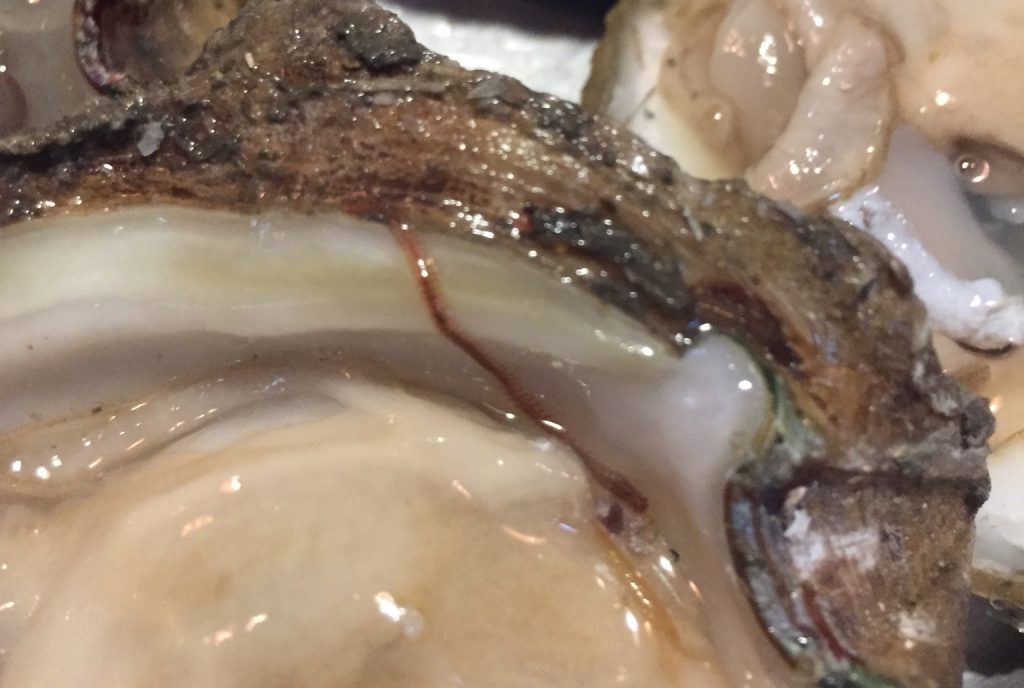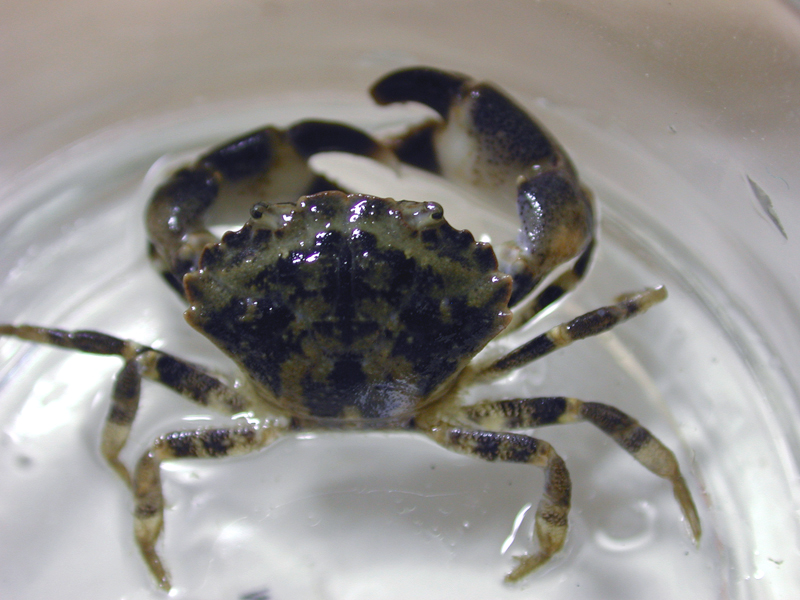Oysters are not only powerful filterers, they also provide a home and habitat for many marine organisms. Most of these organisms will fall off while the oysters are being harvested or cleaned, but some will stay behind and can be found inside or outside of your oyster on the half shell. Seeing some of these creatures might give you the “heebie jeebies” about eating the oyster, they are perfectly safe and can either be removed or, in some cases, consumed for luck. These creatures include mud worms (Polydora websteri), “pea crabs” (Pinnotheres ostreum or Zaops ostreus), and “mud crabs” (Panopeus herbstii, Hexapanopeus angustifrons or Rhithropanopeus harrisii).
Mud Worms (Polydora websteri)
One of the more common marine organisms you can find on an oyster is the oyster mud worm. These worms are typically red in color and form a symbiotic relationship with the oyster. Mud worms can be found in both farmed and wild harvest oysters throughout the United States. These worms will typically form a “mud blister” and emerge when the oyster has been harvested. Even though the worms look menacing and unsightly, they are a sign of a fresh harvest and a good environment. Mud worms do not pose any threat to humans and can be consumed.
If you find a mud worm on your next oyster and are still unsure, just simply remove the worm and dispose of it. Dr. John Supan, retired professor and past director of Louisiana Sea Grant’s Oyster Research Laboratory on Grand Isle, mentioned in an article that oyster mud worms “are absolutely harmless and naturally occurring,” and “if a consumer is offended by it while eating raw oysters, just wipe it off and ask your waiter/waitress for another napkin. Better yet, if there are children at the table, ask for a clear glass of water to drop the worm in. They are beautiful swimmers and can be quite entertaining.”
“Pea Crabs” (Pinnotheres ostreum or Zaops ostreus)
“Pea Crabs” are in fact two different species of crabs lumped together under one name. Pea crabs include the actual pea crab (Pinnotheres ostreum) and the oyster crab (Zaops ostreus). These crabs are so closely associated with oysters that their species name contains some form of the Latin word “ostreum” meaning oyster! Pea crabs are known as kleptoparasites and will embed themselves into the gills of an oyster and steal food from the host oyster. Even though they steal food, they seem to pose no threat to the oyster and are a sign of a healthy marine ecosystem.
Pea crabs are soft-bodied and round, giving them the pea name. Pea crabs can be found throughout the Atlantic coast, but are more concentrated in coastal areas from Georgia to Virginia. While they might look like an alien from another planet, they are considered a delicacy and are typically consumed along with the oyster. If you are brave enough to slurp down a pea crab, you might just be rewarded with a little luck. According to White Stone Oysters, “historians and foodies alike agree that finding a pea crab isn’t just a small treat, it’s also a sign of good luck!”
“Mud Crabs” (Panopeus herbstii, Hexapanopeus angustifrons or Rhithropanopeus harrisii)
Just like pea crabs, “mud crabs” is another name for two different species of crabs commonly found in oysters. These crabs, the Harris Mud Crab (Rhithropanopeus harrisii), Smooth Mud Crab (Hexapanopeus angustifrons), and the Atlantic mud crab (Panopeus herbstii) to name just a few, reach a maximum size of 2 to 8 centimeters and are hard-bodied, unlike the pea crabs. Mud crabs can survive a wide range of salinities, but need cover to survive as these crabs are common prey for most of the oyster habitat dwellers, such as catfish (Ariopsis felis), redfish (Sciaenops ocellatus), and sheepshead (Archosargus probatocephalus). These crabs are not beneficial to an oyster environment as they will seek out young oysters and consume them by breaking the shell with their strong claws. If you find a mud crab in your oyster, this is one to dispose of before consuming. However, these crabs typically live on the outside of an oyster and are typically only found when you buy a sack of oysters and do not have an effect on the quality of the oyster.
Don’t Be Afraid
Hopefully this article has helped shed some light on the creatures you might experience when shucking or consuming oysters. Here is a helpful online tool to help identify some marine organisms associated with clam and oyster farms (Click Here). While most of the organisms can be consumed, we recommend the mud crabs be disposed of due to their hard shells. Remember, some of these organisms can bring you luck and with college football season around the corner, some of us might need all the luck we can get! Bring on the pea crabs!
References Hyperlinked Above
- Bring Some Wild Game To Your Holiday Dinner - December 15, 2025
- Aquaculture in the Southern United States: Part 5 – North and South Carolina - December 8, 2025
- Aquaculture in the Southern United States: Part 4-Louisiana & Mississippi - October 29, 2025



